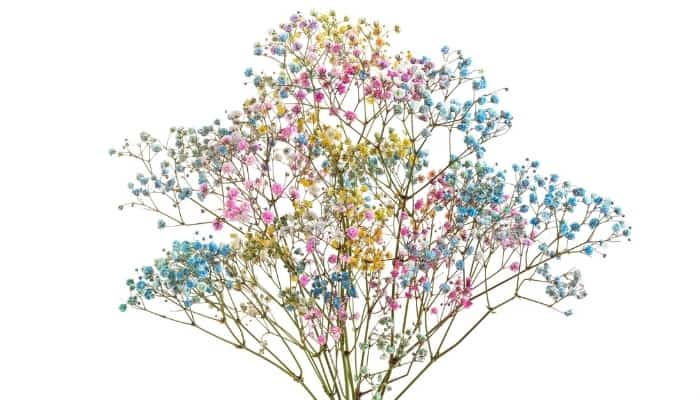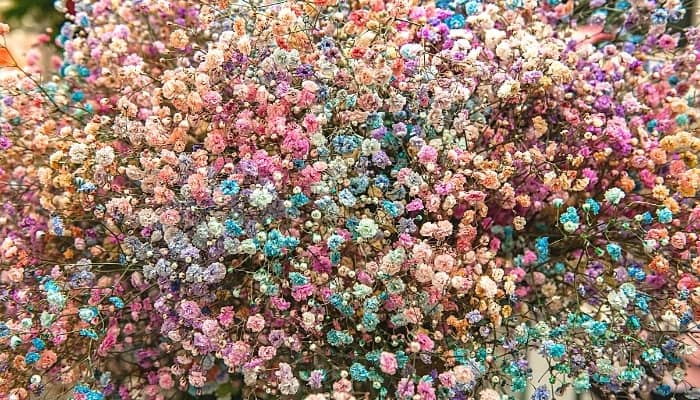Considering growing your own flowers? Look into Unicorn Gypsophila as it is a popular option, particularly for adornment purposes like weddings and floral arrangements.
What is Unicorn Gypsophila? Unicorn Gypsophila is a plant that produces vivid and attractive flowers; the plant is also known as “baby’s breath.” They grow up to two and a half feet tall and have as many as 10 branches that produce bunches of flowers. It comes in multiple colors and can be dyed easily.
Read on below and learn everything that you need to know before you grow your own Unicorn Gypsophila!
Is Gypsophila the Same as Baby’s Breath?
Gypsophila is the botanical name for the plant commonly known as “baby’s breath.”
These flowers have major romantic value and are therefore mainly associated with weddings as they are often used for romantic engagements.
Unicorn Gypsophila Appearance
The Unicorn Gypsophila, or baby’s breath, is a uniquely shaped flower with multiple branches coming off of the main stalk.
Each branch bears dozens of small lance-shaped leaves and scores of tiny flower petal clusters.
The plant is available in several colors including white, pink, yellow, indigo, and blue.
They are most often cut fresh and made into bouquets. They work well in multi-flower bouquets as well as 100% baby’s breath flower bouquets.
The “Unicorn” name is given to baby’s breath bouquets that have been dyed in a variety of bright pastel colors.
Is Unicorn Baby’s Breath Dyed?
Unicorn baby’s breath can be dyed, but it doesn’t need to be. A lot of the time Unicorn baby’s breath is simply several colors of Gypsophila mixed into a single bouquet.
That said, some florists and hobbyists indeed enjoy dying Unicorn baby’s breath to make them even more vivid and interesting to look at.
In the case that Unicorn baby’s breath is dyed, it is likely to have extra bright colors, glitter, and possibly even ribbons or streamers attached to the stems.
Unicorn Gypsophila vs. Rainbow Gypsophila
There is very little difference between Unicorn and Rainbow Gypsophila other than glitter, ribbons, and a bit of spray paint (in many cases).
Unicorn Gypsophila is a colorful Baby’s Breath bouquet with a bit of glitter and pastel paints added to the flowers to make them pop.
Rainbow Gypsophila, on the other hand, typically includes even more brighter, bold colors but lacks all the extra trimmings of Unicorn Baby’s Breath bouquets (such as ribbons and glitter).
Is Gypsophila Perennial?
Gypsophila is indeed a perennial plant. It originates from Europe and belongs to the Caryophyllaceae (carnation) family of plants.
The plant goes dormant each winter, begins growing in the spring, and produces its famous flowers during the summer and fall.
Is Gypsophila Easy To Grow?
Gypsophila is one of the easiest perennial flowers to grow. They are quick and easy to plant and grow in a wide range of climates.
Once established, they basically grow on their own with very little maintenance, like pruning and fertilizing, needed.
Is Gypsophila Poisonous?
Unfortunately, Gypsophila is actually poisonous. The good thing is that it’s not lethal.
Skin and eye irritations as well as asthma and sinus issues are common symptoms of Gypsophila poisoning.
That’s why you should always take precautions when handling/growling baby’s breath, such as always wearing gardening gloves.
Is Baby’s Breath Edible?
Baby’s breath is not edible as it is toxic to humans. If you eat it, the plant induces vomiting, diarrhea, heavy sweating, nervousness, and tremors in most people.
Baby’s Breath Colors
Gypsophila, or baby’s breath, comes in a wide range of colors these days (not including the added splashes of colors found in dyed bouquets).
The most common baby’s breath colors include:
- White
- Pink
- Yellow
- Indigo
- Blue
- Brown
- Orange
- Green
- Purple
It is important to note that because of baby’s breath’s popularity, there are plenty of hybrid varieties available in additional colors.
Dyed Gypsophila
Some florists and flower/décor enthusiasts enjoy dyed Gypsophila, and to be honest, it does look pretty awesome!
Dyed Gypsophila is typically created with dried baby’s breath and spray paint or model paint.
Some hobbyists even include glitter, ribbons, and other extra trimmings on their dyed Gypsophila.
Gypsophila Seeds
If you plant to grow your own Gypsophila, you need some seeds you can count on:
Gypsophila Color Mix
This mix of Gypsophila seed produces standard white and pink flowers as well as potentially blue, purple, or other various colors.
These flowers reach heights of 12 to 18 inches tall. They are GMO free.
Classic White Baby’s Breath
If it’s classic white baby’s breath you’re after, this 300 milligram packet does the trick. These seeds produce thick green foliage with delicate white flowers in clusters.
They are, however, an annual variety. That means they need to be sown each year.
Pink Perennial Gypsophila
These GMO-free seeds produce green lance-shaped foliage and petite pink flowers.
If you plan to plant containers, these seeds do exceptionally well in pots (they basically make little pink and green bushes if you manicure them a bit).
Pink Mix Gypsophila
This pack contains 500 rare flower seeds that produce a variety of whitish-pink flowers. They are the perfect seeds for growing Unicorn Gypsophila.
In addition, the variety can be grown all year in or out of a greenhouse.
Can You Grow Gypsophila in Pots?
Gypsophila grows in pots just as well as any other plant does. In fact, it is highly suggested to grow your baby’s breath in containers versus in the ground because they are so aggressive.
If planted in your flower beds or gardens, Gypsophila are likely to be incredibly invasive. Just make sure to place the pots somewhere that receives at least 6 hours of full sunlight each day.
Gypsophila Planting Guide
Growing Gypsophila is easy-breezy and beautiful:
1. Select a Pot or Plot of Ground
The first step is selecting the place you’re going to grow your baby’s breath.
Choose either a medium-sized pot that you can move around as you please or a plot of garden/flower bed space that gets plenty of light.
2. Prepare the Growing Medium
Whether you’re planting in the ground or in a pot, the next step is preparing the soil/growing medium you’ll be growing in.
If you’re growing in a pot, add potting mix and organic matter. For those planting in the ground, simply turn the soil a bit and add a bit of compost.
3. Plant the Seeds and Water Them
Once you’ve picked your spot or pot and prepared the soil, plant your seeds around ⅛ of an inch deep, cover them with soil, and water them.
Keep the soil evenly moist for 2 weeks. Gypsophila requires 7 to 14 days to germinate and sprout.
Repeat the planting process until you reach thick enough plant growth for your liking.
4. Maintain Proper Moisture and Light Levels
After the Gypsophila you planted begins growing, it’s crucial to keep the growing medium adequately moist.
It’s equally important to continually expose your baby’s breath to 6 hours or more of direct sunlight on a daily basis.

Gypsophila Care
Taking proper care of Gypsophila is quick and easy for the most part, which only adds to the attraction of planting and growing the flower.
A few of the main care points you need to know about Gypsophila are:
Watering
Watering your plant’s growing medium once every 1 to 2 weeks is typically more than enough for Gypsophila.
That said, during heatwaves and the hottest summer months, they may require watering even more frequently.
Use a water meter (this one is reliable and so easy to use!), or check the top inch or two of soil for complete dryness before watering.
Fertilization
Gypsophila doesn’t really need to be fertilized often (if at all), again making it an even more desirable and easy-to-care-for flower to plant and grow.
If you do wish to fertilize your baby’s breath, do it with general-purpose plant food (depending on the product, as often as every watering to as little as once per season or year).
Pruning & Harvesting Flowers
There is technically no need to prune baby’s breath unless you want to tidy them up or harvest flowers for a bouquet.
If you do, simply snip the branches several inches about the main stem. Do not cut below the section where the branches stem out of the main stalk.
Types of Baby’s Breath
There are approximately three dozen endemic species and varieties of baby’s breath. The most popular varieties include:
- Bristol Fairy. One of the main white color types of baby’s breath, it grows up to 4 feet tall.
- Million Star. Perhaps the most famous of all Gypsophila, this one produces white and pinkish flowers and reaches over 2 feet tall on average.
- Pink Fairy. This particular variety is a favorite for those who enjoy pink flowers. It’s easy to grow and maxes out at just 1 1/2 feet in height.
- Compacta Plena. A smaller variety with little white and pink flowers, this type grows to heights of 1 1/2 to 2 feet tall.
- Perfecta. This variety grows up to 3 feet tall and produces medium-size flowers that are white in color.
- Viette’s Dwarf. Another great variety that produces little pink flowers, it reaches a height of just 1 foot tall.
- Queen Anne’s Lace. One of the most well-known types of baby’s breath, Queen Anne’s Lace grows to heights between 1 and 4 feet tall and produces white flowers in clusters that resemble white embroidered lace.
- Festival Star. One of the smallest baby’s breath varieties with white flowers, these plants reach their maximum heights at just 1 foot to 1 1/2 feet tall.
- Other Gypsophila species. Additional mention-worthy baby’s breath varieties include Annual Baby’s Breath (a wild perennial), Orlaya, Funtime, Overtime, and dozens of hybrids.
How To Dye Gypsophila
Dying Gypsophila is a fun and rewarding activity (not to mention a profitable one) for those who enjoy floral decorations.
Dying them is simple:
- Prepare a place for them to dry after they’ve been dyed (cardboard or wax paper is excellent)
- Separate your flowers into separate but tight groupings (tie a string or rubber band around their stems to make sure they stay together)
- Dip each group in the dye of your choice or spray with paint (don’t be afraid to get them wet!)
- Set each group onto the surface you prepared for them to dry on (set them down on their side)
If you want to get fancy with it, consider adding glitter, sprinkles, sparkles, and/or ribbons to the mix as well.
Gypsophila Vase Life
The expected vase life of Gypsophila is around one week (give or take a day or two). There are of course ways to extend their lifespan after being cut but not for much more than a few extra days.
When cutting your Gypsophila for the vase, use a sharp instrument so you get a clean cut. Also, be sure to change the water in the vase daily, and consider adding a small dose of nutrients to the water.
Conclusion
Unicorn Gypsophila is among the most colorful and intriguing baby’s breath varieties out there.
Whether they’ve been dried, dyed, or sparkled or are simply growing organically, they are a definite fan favorite for a real reason: they look amazing.
Hopefully you now know everything you need to know to grow your own!

